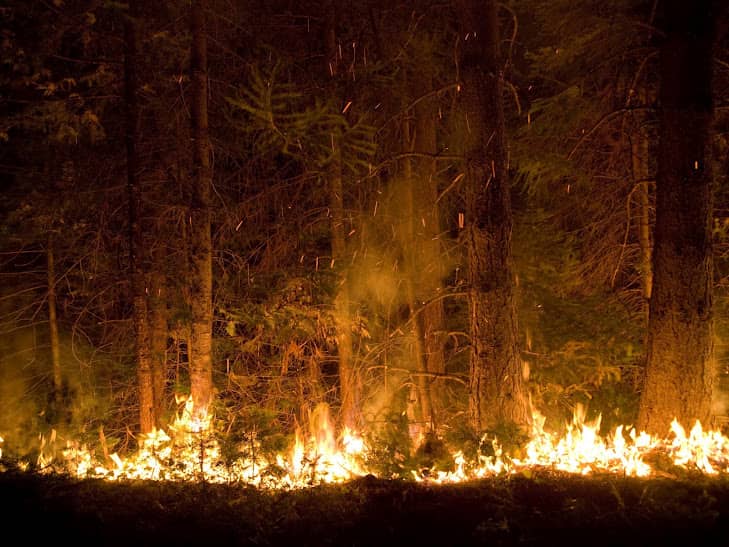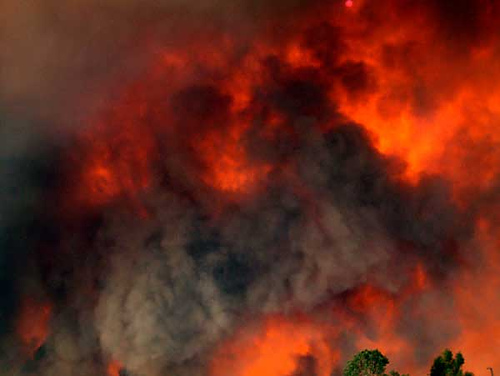The 10 Most Destructive Wildfires in U.S. History
OutdoorHub Reporters 07.02.12

Since accurate accounts of wildfires began being recorded in the United States around the turn of the 20th century, the landscape of the country has changed significantly. Land that was once easy tinder for disastrous infernos is now developed and paved, and wildfire containment is quicker and more effective thanks to a number of new technologies. However, the current fires in Colorado are an obvious indicator that the threat of wildfires will never vanish and some environmental changes may even be exacerbating the problem. To gain some perspective on the fires still being fought today, here is a list of some of the most destructive wildfires in United States history and how they compare to the current firestorms in Colorado.
Wildfires listed here were started both naturally and by humans, and affected mainly uninhabited state- or federally-owned land or private, but remote land.
1. Great Fire of 1910

The Great Fire of 1910 is among the top three worst wildfires in U.S. history. As with most wildfires, it began as a series of scattered wildfires that burned at least three million acres (about the size of Connecticut) across three states. Some people call this the largest wildfire in North American history; hurricane-force winds turned the several hundred smaller fires into two massive conflagrations that spread across Washington, Idaho and Montana. Also known as the Big Blowup or Big Burn, the fires claimed the lives of 86 (some sources say 87) people, 78 of whom were firefighters, though it was not the deadliest. Notably, these fires established policies for fire prevention and suppression for the U.S. Forest Service, which formed just five years before this outbreak.
2. The Deadliest Fire – Peshtigo Fire in Wisconsin
Click the video above to play it
Also known as the “forgotten fire,” the Peshtigo Fire in Wisconsin and Michigan took the lives of anywhere between 1,200 to 2,400 people, though it was less than half the size of the Great Fire of 1910 by acreage burned. Its infamy was largely overshadowed by the Great Chicago Fire (which is not considered a wildfire) that coincidentally began on the same night. Prolonged and widespread drought, high temperatures and a cyclonic storm are what scientists believe to be the cause of the wildfire that began on October 8, 1871. Some theories even suggest that an impact with a comet or meteor sparked the first flames, but the claim was not researched nor documented well enough to be proven.
3. The Great Michigan Fire of 1871

The Great Michigan Fire of 1871 collectively refers to fires in the areas of Holland, Port Huron and Manistee in Michigan’s Lower Peninsula that occurred simultaneously. Just as with the Peshtigo Fire in Wisconsin (which spread to Michigan’s Upper Peninsula), a long and dry summer with hardly any rain created the perfect conditions for wildfires throughout the state. Dried up vegetation and logging debris were the perfect tinder for the fires. Winds from the concurrent Great Chicago Fire are believed to have reinforced the fire. Approximately 2.5 million acres were burned in Michigan (or 3,900 square miles), but the actual losses were never determined. Hundreds were left homeless as the fire burned houses, barns and the lumber that would have been used to rebuild. Figures of the dead were never agreed upon, as while family members reported their dead, lumberjack and salesmen deaths across the state went largely unreported.
4. Summer 2008 California Wildfires

More than 2,780 related fires burned at the height of the catastrophic California Wildfires of 2008. Some were so large that they were visible from space. For three years leading up to the fires, California experienced below-normal rainfall that dried out much of the state’s forests and woodlands. Finally, lightning from thunderstorms ignited the ready-to-burn forest tinder on June 20, though some fires had begun as early as May 22. The fires were so severe that international aid came from Greece, Cyprus, Chile, Argentina, Brazil, Australia, Canada, Mexico and New Zealand.
5. Yellowstone Fires of 1988

One of the driest summers in Yellowstone National Park’s history led to one of the longest burning fires in United States history. In June of 1988, Yellowstone was experiencing a severe drought. A series of natural fires burned out 8,500 acres of the greater Yellowstone are by July 15, but with more visitors arriving, a decision was made to suppress all fires. But within a week, fires encompassed nearly 99,000 acres, with dry fuels and high winds feeding the flames. By August 20, the single worst day of the fires, more than 150,000 acres were engulfed. Through early September, park roads and facilities were closed to the public and nearby residents feared for their property and lives. On September 8, the fires caused the first closure of the entire park to visitors in its history. The fires didn’t dissipate until late autumn brought cooler and moister weather. By the end of the season, a total of 248 fires had taken over more than one million acres of land in the greater Yellowstone area. Fifty of the 248 fires were in the National Park itself.
6. California Cedar Fire 2003

The California Cedar Fire was one of the worst for a number of reasons. Although the total amount of land it occurred across was relatively small compared to the previously mentioned fires, the scorched 280,278 acres contained 2,820 buildings (including 2,232 homes) and killed 15 people, including one firefighter, before it was all over. The fire’s cause was ultimately attributed to a man who lit a fire to signal rescue workers when he became lost in the woods. At first he claimed the fire started because of an accidental gunshot, but he later admitted to becoming lost and igniting timber to create a smoke signal. He was convicted of starting the fire in federal court on October 7, 2004.
7. Oakland Firestorm of 1991

On Saturday, October 19, 1991, someone didn’t fully extinguish a grass fire in the Berkeley Hills area of northern Oakland, California. The resulting flames spread to southeastern Berkeley by the next day and by the end of the day, the fire had burned over 3,000 homes and apartments in the drought-stricken area. At least 24 people died and the total damage was estimated to be at $1.5 billion.
8. Acadia National Park Fire of 1947
httpv://youtu.be/sKgt9G3NZS8
Almost three months of spring rain made Acadia National Park in Maine’s vegetation lush into the summer of 1947. The summer was glorious and hot, but autumn received only 50 percent of its normal rainfall. Vegetation suffered and became bone dry. Precipitation never came and by mid-October a blaze had started. A citizen reported the first smoke on October 17, 1947, although the precise cause remains unknown. Some speculate that a cranberry picker’s cigarette might have started it, or sunlight shining through a piece of broken glass. Nonetheless, the fire made international news as it burned nearly half of the eastern side of Mount Desert Island, five large historic hotels and numerous homes as people fled by sea.
9. Cerro Grande Fire of 2000

The Cerro Grande Fire started as a prescribed burn in May of 2000 in New Mexico. High winds and drought conditions escalated it out of control. Four hundred families lost their homes in the town of Los Alamos, New Mexico where the fired burned 48,000 acres of land. Structures at the Los Alamos National Laboratory (one of the places where the first nuclear bombs were developed in the Manhattan Project) were also destroyed, but luckily, nuclear material there was not damaged. No one lost their lives thanks to the timely evacuation of 20,000 people. Total damages were estimated at roughly one billion dollars.
10. 2002 Hayman Fire in Pike National Forest – Worst in Colorado History?

From June to early July 2002, numerous fires set the stage for what some consider Colorado’s worst wildfire in the state’s history. The Hayman Fire in the Pike National Forest burned 138,000 acres and 133 homes over the span of 20 days. Most of it was contained with the Pike National Forest south and west of Denver and northwest of Colorado Springs. A U.S. Forest Service worker, Terry Lynn Barton, started the fire as she patrolled under a no-burn order. She was charged with four felony counts including willfully and maliciously destroying U.S. property and causing personal injury.
How does the current Colorado fire compare?
Ron Roth, public information officer for the Rocky Mountain Coordination Center, does not yet know whether to say this year’s fire is the worst in Colorado history. Some of the other fire tragedies in the nation’s history were larger in terms of lives lost, acreage covered and property destroyed. Roth says there have been bigger fires by acreage, but if you look at the number of homes that have been lost, 2012’s fire has destroyed the most (roughly 350 homes at time of publication). “You have to look at the individual,” Roth stresses, continuing “if it’s destroyed their home, this is the most destructive fire in history for them.”
In terms of acreage damaged, almost 168,400 acres had been burned at the time of publication according to updates on InciWeb.org, although 98 percent of the fires were still burning. Roth said the Center is not totaling monetary damage estimates as the fires are ongoing. At least $33 million has been spent on fire suppression efforts alone on the High Park Fire and millions more have been spent on the neighboring fires. So far, two deaths have been reported.
For those interested in donating time or money toward recovery efforts, the Rocky Mountain Coordination Center lists these resources:
- The Colorado Red Cross – http://www.coloradoredcross.org 1-800-RED-CROSS
- The Salvation Army – http://imsalvationarmy.org/ 303-866-9216

